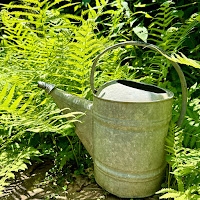As you drive around, you probably see what many of us see:
new construction sites showing Georgia red clay where trees once stood,
new plantings of ornamental exotic plants, and prolific stands of invasive
plants choking our roadsides. It can be depressing and so I offer a selection
of fairly recent stories to help spotlight some good in this area.
Remember that we can also do our part to help improve the
plant landscape in Georgia: educate your friends and neighbors; talk to your
community (HOA, city, county, schools, churches, garden clubs) about the
benefits of native plants and the harm of invasive ones; at all levels, vote
for people who support conservation of land and environmental protections; and
donate to organizations that educate about these issues, fight for these
issues, and that help to conserve habitat.
 |
| Okefenokee view: saw palmetto and longleaf pines |
In Georgia, Okefenokee land purchase: “Thanks to the incredible work of The Conservation Fund, the site of a proposed mine on the doorstep of the Okefenokee National Wildlife Refuge is permanently protected. The Conservation Fund announced the purchase of Twin Pines Minerals’ mine site near the border of the refuge. In addition to the land, the group is also acquiring the underlying mineral rights.” Read the linked article for background and details on why this is such a great achievement. Donations to land conservation organizations make achievements like this possible.
In North Carolina, there is a new promotion effort
by the NC Department of Agriculture for native plants. It is part of the
support for the NC Native Plants Act. They created point of sale kits that contain
a four-foot banner, a yard sign with support, and 50 North Carolina Native
Plant plastic plant labels with logo and area for plant name.
 |
| Point of sale kit (Photo from link above) |
In Alabama, a popular native plant influencer got national recognition for his work. “Kyle Lybarger built a loyal following online by talking about native plants and why biodiversity matters.” The article shares the story of what changed him and some of the other ways he has been able to make a difference, including land conservation.
In Virginia, invasive
plants will get the label they deserve. “Gov. Glenn Youngkin has
signed a bill to require many invasive plant species to be labeled in stores. […]
The law will go into effect in 2027.” Gardeners deserve to know what they’re
getting into: “The list of plants included in the legislation does not include
every invasive species found in Virginia. It does include 39 of the worst
offenders and species that can be commonly found in stores like English ivy,
Bradford pear trees and periwinkle. Oftentimes, gardeners purchase these plants
without knowing the damage they cause to the environment as a whole or the
extent of their impact on their property and neighborhood.”
And in West Virginia, there is hopeful news about cleaning
waterways polluted by years of coal mining. “Mine reclamation has
also historically been more focused on land: moving mountains back into place
after surface mining or filling in hollowed-out spaces underground to prevent
collapse. Water and biodiversity concerns often went unaddressed, even though
acidic runoff can corrode pipes and threaten drinking water for many residents
of rural West Virginia who rely on backyard wells.” In addition, some of the
efforts allow them to extract some rare earth minerals that can be reused.















